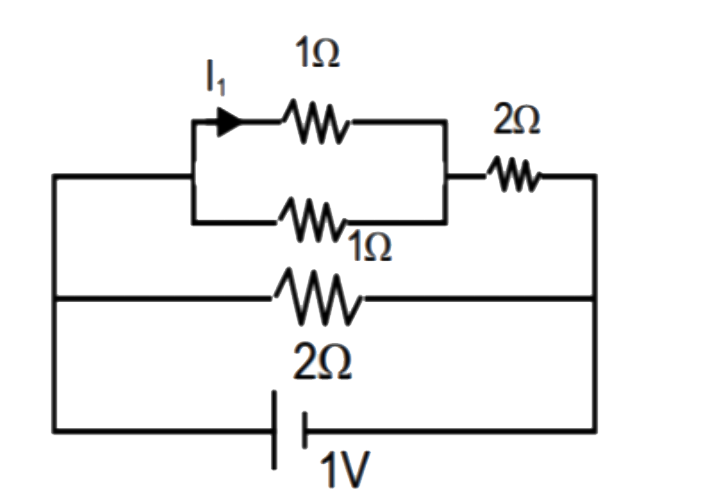Current flowing through a conducting wire is given by
I=(1+2t)
Where t is in seconds and current I is in amperes. The charge (in coulombs) flown through the resistor in the interval from t=0 to t=1 second is -
3
2
1
0
The correct Answer is:B
To find the charge flown through the resistor from t=0 to t=1 second, we start with the given current equation:
I=1+2t
Step 1: Relate Current to Charge
We know that current I is defined as the rate of flow of charge Q with respect to time t:
I=dQdt
Step 2: Substitute the Current Equation
Substituting the expression for current into the equation:
dQdt=1+2t
Step 3: Rearrange the Equation
We can rearrange this equation to isolate dQ:
dQ=(1+2t)dt
Step 4: Integrate Both Sides
Now, we will integrate both sides. The left side will be integrated with respect to Q and the right side with respect to t. The limits for t are from 0 to 1 second, and the initial charge Q at t=0 is 0:
∫Q0dQ=∫10(1+2t)dt
Step 5: Calculate the Integral
Calculating the left side gives:
Q−0=∫10(1+2t)dt
Now, we compute the right side:
∫(1+2t)dt=t+t2
Evaluating this from 0 to 1:
(t+t2)10=(1+12)−(0+02)=1+1−0=2
Step 6: Final Result
Thus, the charge Q that has flowed through the resistor from t=0 to t=1 second is:
Q=2 coulombs
Summary
The charge flown through the resistor in the interval from t=0 to t=1 second is 2 coulombs.
---
We know that current I is defined as the rate of flow of charge Q with respect to time t:
Substituting the expression for current into the equation:
We can rearrange this equation to isolate dQ:
Now, we will integrate both sides. The left side will be integrated with respect to Q and the right side with respect to t. The limits for t are from 0 to 1 second, and the initial charge Q at t=0 is 0:
Calculating the left side gives:
Thus, the charge Q that has flowed through the resistor from t=0 to t=1 second is:
The charge flown through the resistor in the interval from t=0 to t=1 second is 2 coulombs.
Topper's Solved these Questions
- BOOK - RESONANCECHAPTER - DAILY PRACTICE PROBLEMEXERCISE - DPP No.379videos
DAILY PRACTICE PROBLEM
- BOOK - RESONANCECHAPTER - DAILY PRACTICE PROBLEMEXERCISE - DPP No.3820videos
DAILY PRACTICE PROBLEM
- BOOK - RESONANCECHAPTER - DAILY PRACTICE PROBLEMEXERCISE - DPP No.3520videos
DAILY PRACTICE PROBLEM
- BOOK - RESONANCECHAPTER - CURRENT ELECTRICITYEXERCISE - High Level Problems (HIP)21videos
CURRENT ELECTRICITY
- BOOK - RESONANCECHAPTER - ELECTRO MAGNETIC WAVESEXERCISE - Exercise 327videos
ELECTRO MAGNETIC WAVES
Similar Questions
Knowledge Check
- Question 1 - Select One
The current I through a given cross -section varies with time t as I=3+2t , where l is in ampere and t is in second. The charge passed through this cross-section during t=0 to t=2 s is
A7CB10CC14CD20C - Question 2 - Select One
The electric current in a circuit is given by
i=3t
Here, t is in second and I in ampere. The rms current for the period to=0 to t=1 s isA3ABSC√AD3√3A - Question 3 - Select One
Charge Q passing through a cross-section of conductor at an instant is given by Q=(0.5t2+t)C where t is in second . Current through the conductor at t=1 is
AZeroB1AC2AD−1A
Current flowing through an inductor as a function of time is given as follows :
I = 4 + 16 t. here I is in amperes and t is in seconds. Emf induced in the inductor is 20 mV.
Rate of energy supplied to inductor at t = 2 s isView SolutionIf the current through an inductor of 2 H is given by I=tsintA, then the voltage across the inductor is
View SolutionA change Q flowing through a conductor , beginning with time t=0, is given by Q=3t2+2t+. If the intensity of the current is the rate of change of Q w.r.t. t, then the intensity at the end of the fifth second is
View SolutionThe current flowing through wire depends on time as, I=3t2+2t+5
The charge flowing through the cross - section of the wire in time t=0 to t=2 second isView SolutionThe current in conductor varies with time t as I=2t+3t2 where I is in ampere and t in seconds. Electric charge flowing through a section of the conductor during t=2sec to t=3sec is
View Solution


